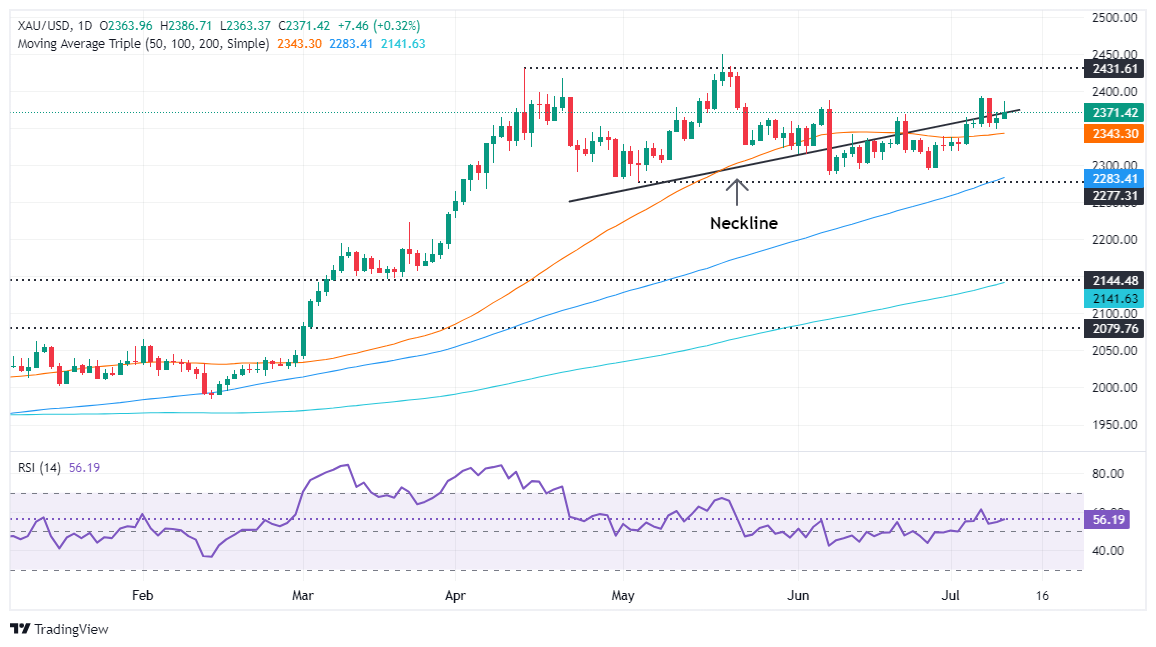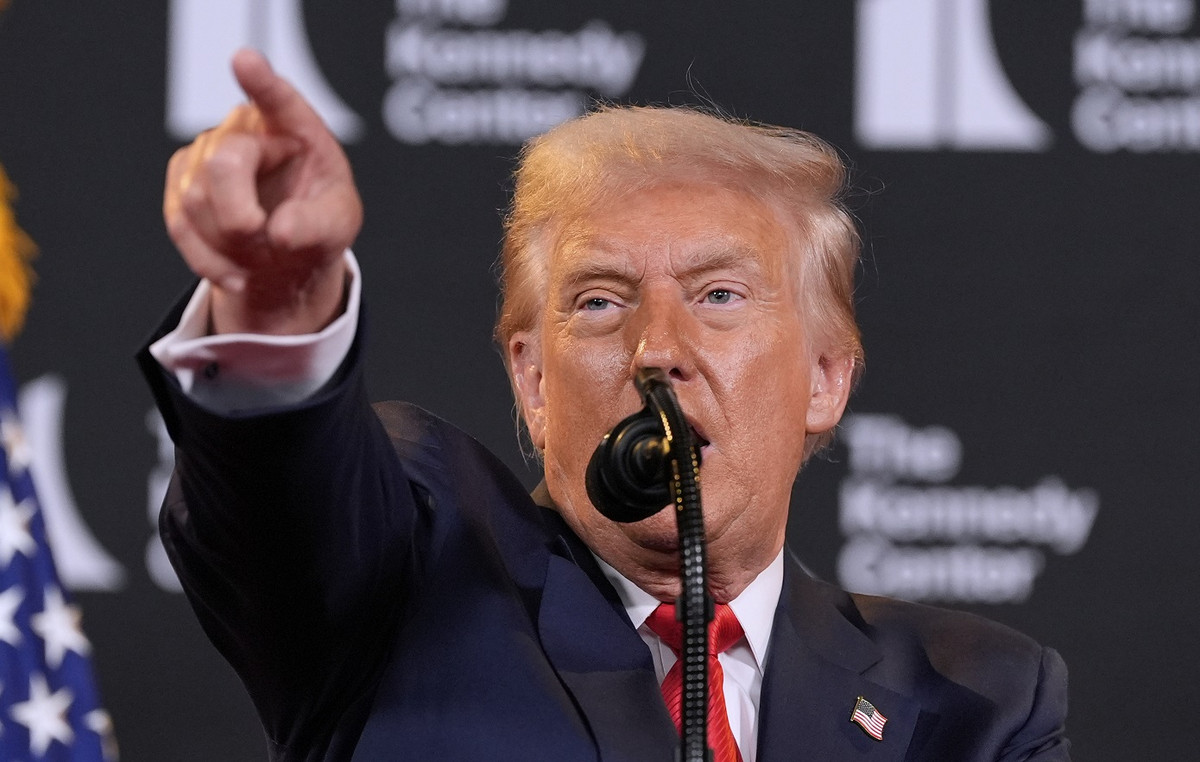- Gold soars on rising expectations of Fed rate cuts in September.
- The yield on the 10-year US Treasury bond fell to 4.288%, while the Dollar Index fell below 105.00.
- Gold ETF inflows support the metal, with eyes on US June inflation data and economic indicators.
The price of Gold The dollar soared on Wednesday for the second consecutive day amid growing speculation that the Federal Reserve (Fed) could start cutting interest rates at the September meeting. Consequently, US Treasury bond yields and the Dollar fell, a tailwind for the golden metal. The XAU/USD is trading at $2.372, up more than 0.30%.
Falling US Treasury bond yields and a weak US dollar boosted the yieldless metal. The US 10-year Treasury bond yield fell one and a half basis points (bps) to 4.288%, while the US Dollar Index (DXY) was below 105.00, shedding 0.06%.
In his appearance before the U.S. House of Representatives, Fed Chairman Jerome Powell repeated most of his comments made to a U.S. Senate committee on Tuesday. He acknowledged progress on inflation, but Powell said the board is not confident that cutting rates will help prices reach the 2% target.
Despite ongoing setbacks, gold remains supported by a second consecutive month of inflows into gold exchange-traded funds (EFTs) in June, driven by additions to the holdings of listed funds in Europe and Asia.
With Fed Chair Powell’s semi-annual testimony in the rearview mirror, investors are looking ahead to the release of US June inflation figures on Thursday. That, Initial Jobless Claims and the University of Michigan Consumer Sentiment data will determine the direction of Gold.
Daily Market Wrap: Gold prices soar on Fed rate cut hopes
- US CPI is expected to decline from 3.3% to 3.1% year-on-year in June, while core inflation is projected to remain stable at 3.4% year-on-year.
- According to consensus, Initial Jobless Claims for the week ending July 6 are expected to rise from 238,000 to 240,000.
- July consumer sentiment is forecast to improve to 68.5, up from 68.2 in June, according to consensus.
- Bullion prices retreated somewhat due to the People’s Bank of China’s (PBoC) decision to halt gold purchases in June, as it did in May. China held 72.80 million troy ounces of the precious metal at the end of June.
- According to data from the CME FedWatch tool, investors are pricing in a 71% chance of a Fed rate cut in September, up from 70% on Tuesday.
- The December 2024 federal funds rate futures contract implies the Fed will ease policy by 39 basis points (bps) by the end of the year.
Technical Analysis: Gold Price Consolidates Around $2,370
Despite forming a bearish Harami candlestick pattern after breaking the neckline of the head and shoulders pattern, Gold has resumed its ongoing uptrend, albeit still failing to reach the weekly highs set on Monday at $2,391 per troy ounce.
Momentum has shifted in favor of buyers as shown by the RSI, which remains bullishly above the neutral line of 50 and points higher.
Therefore, the path of least resistance is to the upside. The first resistance for XAU/USD would be the July 5 high at $2,392, followed by the $2,400 figure. Further upside is expected, with the next resistance at the yearly high of $2,450, before $2,500.
Conversely, if XAU/USD drops below $2,350, the gold metal could decline to the $2,300 level. If this support fails, the next demand zone would be the May 3 low of $2,277, followed by the March 21 high of $2,222.
The Fed FAQs
Monetary policy in the United States is directed by the Federal Reserve (Fed). The Fed has two mandates: to achieve price stability and to promote full employment. Its main tool for achieving these goals is to adjust interest rates. When prices rise too quickly and inflation exceeds the Fed’s 2% target, the Fed raises interest rates, increasing borrowing costs throughout the economy. This translates into a strengthening of the US Dollar (USD), as it makes the US a more attractive place for international investors to park their money. When inflation falls below 2% or the unemployment rate is too high, the Fed can lower interest rates to encourage borrowing, which weighs on the greenback.
The Federal Reserve (Fed) holds eight meetings a year, at which the Federal Open Market Committee (FOMC) assesses economic conditions and makes monetary policy decisions. The FOMC consists of twelve Federal Reserve officials: the seven members of the Board of Governors, the president of the Federal Reserve Bank of New York, and four of the eleven regional Reserve bank presidents, who serve one-year terms on a rotating basis.
In extreme situations, the Federal Reserve may resort to a policy called Quantitative Easing (QE). QE is the process by which the Fed substantially increases the flow of credit into a jammed financial system. It is a non-standard policy measure used during crises or when inflation is extremely low. It was the Fed’s weapon of choice during the Great Financial Crisis of 2008. It involves the Fed printing more dollars and using them to buy high-quality bonds from financial institutions. QE typically weakens the US dollar.
Quantitative tightening (QT) is the reverse process of QE, whereby the Federal Reserve stops buying bonds from financial institutions and does not reinvest the capital of maturing bonds in its portfolio to buy new bonds. It is usually positive for the value of the US dollar.
Source: Fx Street
I am Joshua Winder, a senior-level journalist and editor at World Stock Market. I specialize in covering news related to the stock market and economic trends. With more than 8 years of experience in this field, I have become an expert in financial reporting.








